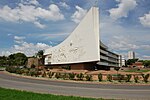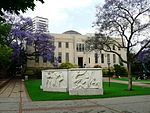Public Protector
The Public Protector in South Africa is one of six independent state institutions set up by the country's Constitution to support and defend democracy. According to Section 181 of the Constitution: These institutions are independent, and subject only to the Constitution and the law. According to the Constitution, they must be impartial and must exercise their powers and perform their functions without fear, favour or prejudice. Other organs of state, through legislative and other measures, must assist and protect these institutions to ensure the independence, impartiality, dignity and effectiveness of these institutions. No person or organ of state may interfere with the functioning of these institutions. These institutions are accountable to the National Assembly, and must report on their activities and the performance of their functions to the Assembly at least once a year.
Excerpt from the Wikipedia article Public Protector (License: CC BY-SA 3.0, Authors).Public Protector
Lunnon Road, Pretoria Hillcrest
Geographical coordinates (GPS) Address Phone number Website External links Nearby Places Show on map
Geographical coordinates (GPS)
| Latitude | Longitude |
|---|---|
| N -25.757869 ° | E 28.240425 ° |
Address
Public Protector
Lunnon Road 175
0083 Pretoria, Hillcrest
Gauteng, South Africa
Open on Google Maps



